
Senecio is a genus of flowering plants in the daisy family (Asteraceae) that includes ragworts and groundsels.

Kunzea ericoides, commonly known as kānuka, kanuka, or white tea-tree, is a tree or shrub in the myrtle family, Myrtaceae and is endemic to New Zealand. It has white or pink flowers similar to those of Leptospermum and from its first formal description in 1832 until 1983 was known as Leptospermum ericoides. The flowers have five petals and up to 25 stamens which are mostly longer than the petals.

Bedfordia is a genus of flowering plants belonging to the family Asteraceae. The genus includes 3 species, all endemic to Australia.

Senecio angulatus, also known as creeping groundsel and Cape ivy, is a succulent flowering plant in the family Asteraceae that is native to South Africa. Cape ivy is a scrambling herb that can become an aggressive weed once established, making it an invasive species. It has been naturalised in the Mediterranean Basin, where it is grown as an ornamental plant for its satiny foliage and sweet-scented flowers.
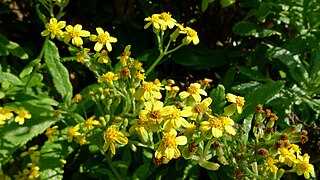
Senecio madagascariensis, also known as Madagascar ragwort, is a species of the genus Senecio and family Asteraceae that is native to Southern Africa. Other common names include Madagascar groundsel and fireweed. It has been included on the noxious weeds list for Hawaii and the reject list for Australia. S.madagascariensis is the diploid cytotype of S.inaequidens.

Philotheca spicata, commonly known as pepper and salt, is a species of flowering plant in the family Rutaceae and is endemic to the south-west of Western Australia. It is a small shrub with linear to narrow elliptical leaves and pink, mauve or blue flowers arranged in a raceme on the ends of branchlets.
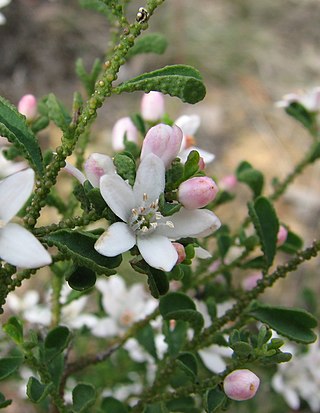
Philotheca verrucosa, commonly known as fairy wax-flower or Bendigo wax-flower, is a species of flowering plant in the family Rutaceae and is endemic to south-eastern Australia. It is a small shrub with prominently glandular-warty branchlets, heart-shaped or egg-shaped leaves with the narrower end towards the base, and white flowers usually arranged singly in leaf axils.

Senecio pinnatifolius is a species of herb native to Australia. Common names include coast groundsel, dune groundsel and variable groundsel.

Dillwynia cinerascens, commonly known as grey parrot-pea, is a species of flowering plant in the family Fabaceae and is endemic to south-eastern Australia. It is an erect to low-lying shrub with linear or thread-like leaves and orange or yellow flowers.
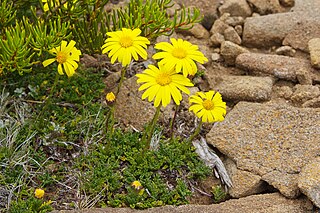
Scapisenecio pectinatus, synonym Senecio pectinatus, commonly known as alpine groundsel, is a species of flowering plant in the aster family. The species occurs in alpine areas of south-eastern Australia in peat-based soils. It has divided leaves forming a basal rosette and produces a single yellow flower head on a stalk up to 20 cm high.
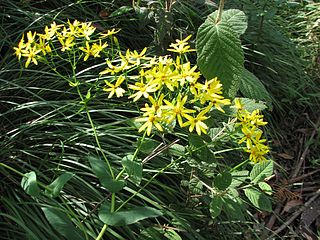
Lordhowea velleioides, synonym Senecio velleioides, is a species of flowering plant in the family Asteraceae. It is commonly known as forest groundsel.

Erechtites glomeratus, common name New Zealand fireweed, or cutleaf burnweed, or fireweed or Cluster-headed fireweed, is a species of plant in the sunflower family. It is native to Australia and New Zealand, and also naturalized on the Pacific Coast of the United States.

Brachyscome graminea, commonly known as grass daisy, is a perennial herb in the family Asteraceae and is endemic to Australia. It has mostly mauve-pink or purple daisy-like flowers and a yellow centre.
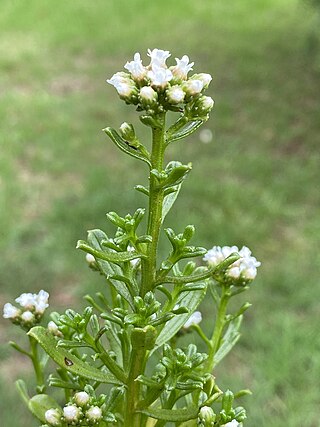
Ixodia achillaeoides, commonly known as mountain daisy, is a species of flowering plant in the family Asteraceae and is found in South Australia and Victoria. It is a small shrub with sticky, smooth branchlets and small white flowers in spring and summer.

Senecio quadridentatus is native to Australia and New Zealand. In New Zealand it is known by its Māori name pahokoraka or pekapeka. Senecio quadridentatus is an annual or perennial herbaceous flowering plant in the family Asteraceae. It is also known as Erechtites quadridentata Labill by the synonyms.

Senecio vagus, commonly known as saw groundsel, is a species of flowering plant in the daisy family Asteraceae. This plant occurs in the Australian states of New South Wales, Victoria and Tasmania. An erect perennial herbaceous plant, growing up to 1.5 metres tall. Mostly seen in moist gullies on the Great Dividing Range. Yellow flowers usually form in spring and summer. The lectotype was collected in the Dandenong Ranges in 1853 by Ferdinand von Mueller.
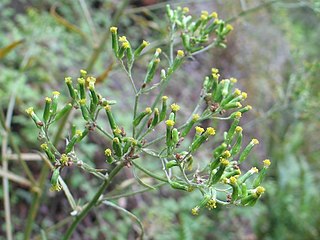
Senecio minimus, commonly known as toothed fireweed and coastal burnweed, is a species of plant in the sunflower family. It is native to Australia and New Zealand, and also naturalized on the Pacific Coast of the United States.
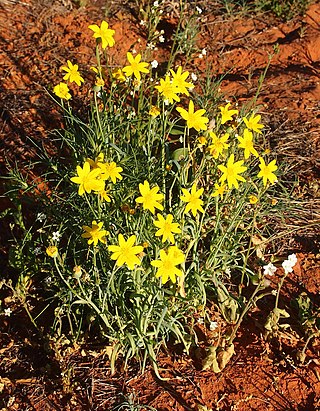
Senecio gregorii, commonly known as annual yellowtop or fleshy groundsel, is a native Australian wildflower species, found in arid and semi-arid regions of the Australia and across the globe. It often grows prolifically after autumn/winter rains, showcasing stunning yellow flowers and fleshy foliage. The scientific name of this species was first published by Ferdinand von Mueller.

Vittadinia muelleri, commonly known as narrow-leaf New Holland daisy, is a flowering plant in the family Asteraceae. It is a small perennial forb with bright green leaves and purple daisy-like flowers. It grows in New South Wales, Victoria, Tasmania and the Australian Capital Territory.

Brachyscome spathulata, commonly known as spoon-leaved daisy, is a flowering plant in the family Asteraceae. It has dark green leaves, mauve daisy-like flowers and grows in New South Wales, Tasmania, Victoria and the Australian Capital Territory.





















